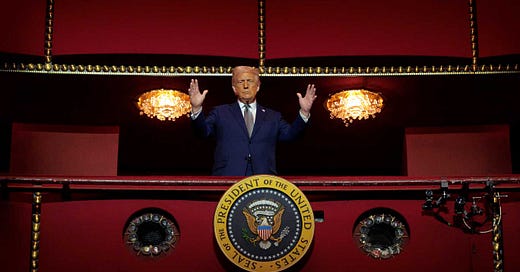
The Free Press

Are Elon Musk and the DOGE boys disrupters or vandals? Should Robert F. Kennedy Jr. be in charge of public health? Does the footage of the USAID sign being removed from a government building fill you with excitement or dread? Do Tulsi Gabbard’s criticisms of the “deep state” make her unfit for the role of director of national intelligence—or precisely the woman for the job?
A good predictor of how you answer these questions—better perhaps than whether you are a Republican or a Democrat—is whether or not you are a “brokenist.”
That term, coined by Tablet editor-in-chief Alana Newhouse a few years ago, has been bouncing around my head ever since Trump returned to power last month. In fact, I’m increasingly convinced it’s the key to understanding this administration. Allow me to explain.
In January 2021, Newhouse wrote an essay addressing what she would later describe as “the growing sense, made more glaring during the first year of the pandemic, that whole parts of America were breaking down before our eyes.” She argued that major institutions of American life—from the media to medicine—no longer worked. “Everything Is Broken,” was Newhouse’s unsparing conclusion—and the essay’s memorable headline.
Almost two years later, Newhouse wrote a follow-up, titled “Brokenism,” which translated the ideas of her first essay into a new political rubric. The most important divide in our politics, she argued, wasn’t between left and right, but between “brokenists” and “status-quoists.” Brokenists can be on the left or the right, or in the middle, but they agree that “what used to work is not working for enough people anymore.” Status-quoists, by contrast, “are invested in the established institutions of American life, even as they acknowledge that this or that problem around the margins should of course be tackled.” Bernie Sanders? Brokenist. Liz Cheney? Status-Quoist. Or—to pick further examples Newhouse doesn’t name in her piece—Joe Rogan? Brokenist. Matthew Yglesias? Status-quoist. (Presciently, Newhouse identified Marc Andreessen and Elon Musk as two tech world brokenists—two years before they would come out for Trump.)
Newhouse’s argument struck me as obviously true and important back in 2022. It explained how tech, Trump’s first term, Covid, wokeness, and so much else had combined to scramble our politics. After almost a month of Trump’s second term, “brokenism” looks like a more important idea than ever—the thread that connects so much of the revolution underway in Washington, D.C.
Does Newhouse agree? “100 percent,” she said when we spoke over the phone recently. This administration and its supporters are, she said, “a coalition of people who feel that whole parts of America’s governing bodies have decayed past the point of usability.”
J.D. Vance more or less tweeted as much last month when—in a push to secure the votes needed to confirm Gabbard as Trump’s intelligence chief and RFK Jr. as secretary of Health and Human Services—he wrote that these former Democrats “represent parts of the new coalition in our party. To say they’re unwelcome in the cabinet is to insult those new voters.”
In other words, what binds that new coalition is brokenism.
Gabbard, a military veteran and former Democratic lawmaker from Hawaii, was picked because she, like Trump, believes our intelligence agencies are broken. “For too long, faulty, inadequate, or weaponized intelligence has led to costly failures and the undermining of our national security,” she said in the opening statement of her confirmation hearing.
At his confirmation hearing, RFK Jr. took aim at a broken health system. The U.S. “has worse health than any other developed nation,” he said. The fact that he has long been pro-choice—a stance he only started to move away from after joining Trump’s team—didn’t matter. Well, it did to the editors of National Review, but the fact that their opposition didn’t make a difference only confirms the brokenism realignment. As does the fact that Chip Roy, a conservative Texas congressman and a staunch pro-lifer, enthusiastically backed RFK’s nomination. Read his explanation as to why in our pages and it’s clear that the thing he and RFK agree on—and the thing that really matters to Roy—is that America’s public health system doesn’t work and requires something more like revolution than reform. Whatever profound differences of opinion they have on other things, including abortion, are secondary.
You might think that the biggest Senate holdouts in the nomination fights over two former Democrats would be ultra-conservatives. Instead they were the self-styled moderates who are generally keen to preach the virtue of bipartisanship. According to the old left-right rules, this makes no sense. Viewed through a brokenist lens, it’s obvious. Mitch McConnell—the only Republican to vote against both Gabbard and RFK—is a quintessential status-quoist.
Time will tell if the brokenist coalition is durable. Indeed, the infighting has already begun. Take, for example, the fight between Elon Musk and Steve Bannon which flared up over legal immigration last month. (Bannon called Musk “truly evil” for supporting H-1B visas for skilled workers.) Their disagreement is broader than that, though. Bannon views Musk as a neoliberal plutocrat and threat to authentic MAGA populism—the problem, not the solution. “Bannon is a great talker, but not a great doer,” said Musk in response.
For Newhouse, what’s interesting about the Musk-Bannon debate “is that they’re both brokenists. What they’re fighting about is what to replace it with.”
“It’s part of the reason why I think the right has all this energy,” she said. “Because they’re not having fights about whether or not we should defend the old stuff. They’re having fights about what to replace the old, broken stuff with.”
For others, these fissures show the limitations of the brokenist framework. Yuval Levin is a scholar at the American Enterprise Institute who has spent a lot of time thinking about why we’ve lost faith in our institutions and what to do about it.
“I think it’s not so much status-quoists and brokenists as something more like building crews and demolition crews,” he told me. “There’s work needed. The institutions are broken. I think there’s broad agreement on that. The question is, is the work that is needed demolition or construction?”
Newhouse may be a brokenist, but she’s interested in construction, not demolition. “One of the misimpressions about the piece and about me in general is that I want to burn stuff down,” she said. “I don’t want anyone to use their energy to do that, right? It’s just about where we put our resources. Which institutions are worth putting our energy into?”
Brokenism explains why, for those of us in the news business, every day feels like a week at the moment. Part of this is down to Trump’s own mode of operation: the off-the-cuff remarks, the late-night posts on Truth Social, the almost daily press conferences, the “flood the zone” approach. But the frenetic energy in Washington stems from the fact the brokenists aren’t outsiders any more. They’re in charge.
“Every day feels like a roller coaster,” explained Newhouse, “because now the people who want others to focus on what’s broken are in power, which means we all have to focus on what’s broken every day. We all have to wake up and see some new evidence of some new thing that is broken beyond what any of us could have imagined.
“There was no lever to pull in the last election for ‘change, but make it responsible and well-paced,’ ” added Newhouse. “The choice was between a slow canoe ride through more of the same, or a roller coaster. Americans chose the roller coaster.”
Under Joe Biden, Washington was run by people eager to cover up or minimize problems—including the president’s own mental decline. The new administration sees its job as being to expose those issues for all to see. Whether or not it will fix them is another story.
Levin recognizes the “weirdness” of institutions being run by people whose “basic ambition is to tear those institutions down.” And he’s skeptical that strategy will work: “To run for office and to want to be a public official is to want to be an insider, to think that there is work to be done inside the institutions that could be constructive for society. If you don’t think that, then you’re not really going to be able to play the role that our system assigns to insiders.”
Whether or not the Trump administration is capable of fixing the institutions it considers broken, its efforts to do so will lead to much tension and drama in Washington. For those of us in the news business, it’s been exhausting. And it’s only been a month. But Newhouse thinks it’s invigorating. “The brokenists say, ‘We can do better. We can make something better than this.’ Is it an exhausting challenge? It is. Is it more exhausting to sit in the misery and the stagnation of institutions that are broken? Many Americans certainly think so.”
As Newhouse put it in her essay a little over two years ago: “The ground is moving again. Everything bad comes from change, but so does everything good.”













